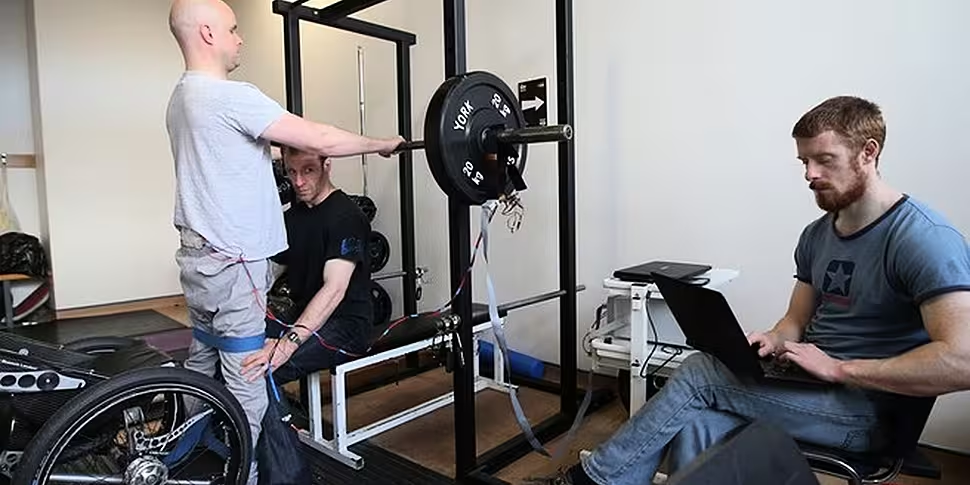Adventurer Mark Pollock, who was paralysed following an accident in 2010, has stood up on his own for the first time.
Pollock has been taking part in a research study at Trinity College Dublin where scientists have been attaching electrodes to his back via patches to stimulate his nervous system, and on November 10th 2015 he was able to stand unassisted for a few seconds.
For Newstalk's Futureproof, Jonathan McCrea interviewed to Mark to find out more about the therapy he is receiving and to hear the events of that amazing day last November.

Professor Reggie Edgerton, Jonathan McCrea, Mark Pollock and Simone George
At the age of 22, Mark Pollock lost his sight when his left retina became detached.
Since then Mark has competed in ultra endurance races across deserts, mountains, and the polar ice caps and in 2009 he became the first blind person to reach the South Pole.
In July 2010, just weeks before his wedding, Mark fell through a second story window of a friend’s house onto the patio below fracturing his skull and damaging his spinal cord in two places. From that moment Mark was paralysed and confined to a wheelchair.
His fiancée Simone George spent the first months after his accident by his beside administering care: "Mark wasn’t doing anything other than holding on to the mattress and hoping not to die".
She also spent hours online educating herself on every aspect of his condition, reading about various treatments and studies.
She eventually came across the work of Professor Reggie Egderton from UCLA. He has been using spinal stimulation to try to get his patients standing and walking again.
Mark and Simone asked Edgerton to travel to Ireland to set up a similar study with Mark as a volunteer and he agreed.
Transcutaneous Spinal Stimulation
Mark is currently undertaking ‘transcutaneous spinal stimulation’ at Trinity College in Dublin (YCD). Professor Reggie Edgerton is lead researcher, and collaborates with Yuri Gerasemenko of the Pavlov Institute.
The study is non-invasive and involves electrodes attached to the back via patches. The electrodes stimulate his nervous system at various parts of his spine.
Irish scientist Neil Fleming, who is continuing Edgerton's work in Trinity, explained the science behind the study, beginning with how our muscles work.
"Electrical signals are sent from the motor cortex in the brain and they travel down the spinal cord".
"We have motor-neurons embedded in the spinal cord the whole way down that will then send an electrical impulse out to the muscles and we get a 'muscle action potential".
"Muscle action potential' then allows for the contractile elements within the muscles to interact and that creates movement".
"When a spinal cord injury is present “that connection from the brain to the muscles has been broken somewhere along the way".
In Mark’s case, he suffered a complete spinal cord injury meaning his brain can’t talk to his lower spine, and for decades scientists have believed that patients like Mark will never be able to walk again because of this.
The Process
The team at Trinity are focusing their efforts on so-called Central Pattern Generators or CPGs.
CPGs are a collection of neurons in the lower spinal cord that control automatic movements like walking, swimming, and flying – in animals.
For a long time it was thought that CPGs only existed in four-legged humans, and not in humans.
Professor Edgerton explained: "What we’re trying to do is provide a level of current electricity over the spinal cord that will make this spinal cord want to generate those patterns that will step or will stand".
Neil sends electrical currents into Mark’s back while he trains by walking in his exoskeleton – a very futuristic looking harness that has motors to help his legs to walk.

Mark Pollock using the Ekso Bionics robotic exoskeleton | Image: COPYRIGHT MARK POLLOCK TRUST
The idea is to trick his body into feeling that he is actually walking hoping that somehow this sensation will provide the feedback that will push his muscles over the edge and into action.
Neil says in the US that long-term training has enabled "complete spinal cord injured individuals to stand unassisted, and to walk with minimal assistance".
"Spinal stimulation is in its infancy as a technology and most of the research that’s been published has been epidural spinal stimulation" - which uses implants in the spine.
Transcutaneous spinal stimulation is a much newer technology and is non-invasive.
Standing Up For the First Time
On November 10th Mark and the team had a visit from a UCLA scientist who was passing through Dublin on his way to Russia.
He tried a different type of stimulation on Mark’s back called ‘monophasic’ stimulation, which is a bit more ‘dangerous‘ than his current regime and can cause irritation to the skin.
In the interview with Futureproof, Simone George explained what happened on the day.
Mark began standing a squat rack using his arms to hold him up, while his physio braced his knees to prevent them from buckling.
Dimitri the UCLA scientist then turned the stimulation on and asked the physio to move his hands away from Mark’s body.
Following some chat back and forth, and help from Dimitri, the physiotherapist let go, and Mark Pollock stood on his own for a just few seconds.
This is the video of Mark standing unassisted for the first time:
"It was the most beautiful, beautiful thing I've ever seen" said Simone, recalling the day.
"It was an amazing breakthrough,” explained Mark, “It was incredible to be standing free of any support".
Since beginning the research, Mark has been able to get his heart rate up, he has begun to sweat in training and can walk in his exoskeleton for more than 45 minutes per session as opposed to just 15.
The other thing to note is that this sort of training yields measurable and important benefits for paralysed patients including improved overall health, mood and bladder and erectile function.
These often do not even register as problems to those who can walk in comparison to paralysis, but for patients they are a very big deal.
Since his accident, Mark has made it his mission to find a cure for paralysis and serves on the board at the Christopher Reeve Foundation.
In 2011, Mark set up The Mark Pollock Trust and runs an annual event called the Run in the Dark. It takes place in several locations worldwide to raise funds for his work, raising awareness and funding research.









